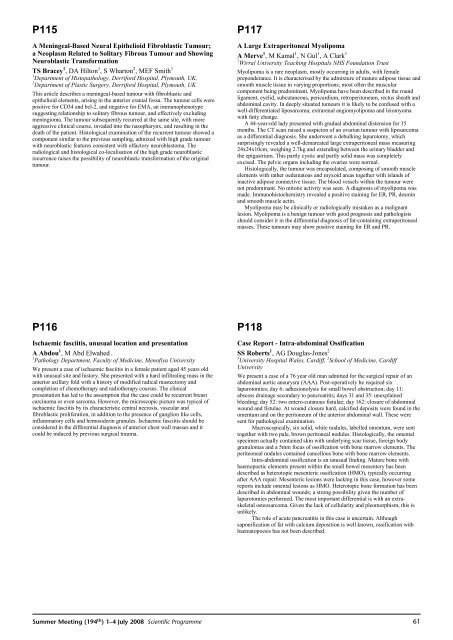2008 Summer Meeting - Leeds - The Pathological Society of Great ...
2008 Summer Meeting - Leeds - The Pathological Society of Great ...
2008 Summer Meeting - Leeds - The Pathological Society of Great ...
Create successful ePaper yourself
Turn your PDF publications into a flip-book with our unique Google optimized e-Paper software.
P115A Meningeal-Based Neural Epithelioid Fibroblastic Tumour;a Neoplasm Related to Solitary Fibrous Tumour and ShowingNeuroblastic TransformationTS Bracey 1 , DA Hilton 1 ,SWharton 2 , MEF Smith 11 Department <strong>of</strong> Histopathology, Derriford Hospital, Plymouth, UK,2 Department <strong>of</strong> Plastic Surgery, Derriford Hospital, Plymouth, UKThis article describes a meningeal-based tumour with fibroblastic andepithelioid elements, arising in the anterior cranial fossa. <strong>The</strong> tumour cells werepositive for CD34 and bcl-2, and negative for EMA, an immunophenotypesuggesting relationship to solitary fibrous tumour, and effectively excludingmeningioma. <strong>The</strong> tumour subsequently recurred at the same site, with moreaggressive clinical course, invaded into the nasopharynx, and resulting in thedeath <strong>of</strong> the patient. Histological examination <strong>of</strong> the recurrent tumour showed acomponent similar to the previous sampling, admixed with high grade tumourwith neuroblastic features consistent with olfactory neuroblastoma. <strong>The</strong>radiological and histological co-localisation <strong>of</strong> the high grade neuroblasticrecurrence raises the possibility <strong>of</strong> neuroblastic transformation <strong>of</strong> the originaltumour.P117A Large Extraperitoneal MyolipomaAMerve 1 ,MKamal 1 ,NGul 1 , A Clark 11 Wirral University Teaching Hospitals NHS Foundation TrustMyolipoma is a rare neoplasm, mostly occurring in adults, with femalepreponderance. It is characterised by the admixture <strong>of</strong> mature adipose tissue andsmooth muscle tissue in varying proportions; most <strong>of</strong>ten the muscularcomponent being predominant. Myolipoma have been described in the roundligament, eyelid, subcutaneous, pericardium, retroperitoneum, rectus sheath andabdominal cavity. In deeply situated tumours it is likely to be confused with awell-differentiated liposarcoma, extrarenal angiomyolipoma and leiomyomawith fatty change.A 44-year-old lady presented with gradual abdominal distension for 15months. <strong>The</strong> CT scan raised a suspicion <strong>of</strong> an ovarian tumour with liposarcomaas a differential diagnosis. She underwent a debulking laparotomy, whichsurprisingly revealed a well-demarcated large extraperitoneal mass measuring24x24x10cm, weighing 2.7kg and extending between the urinary bladder andthe epigastrium. This partly cystic and partly solid mass was completelyexcised. <strong>The</strong> pelvic organs including the ovaries were normal.Histologically, the tumour was encapsulated, composing <strong>of</strong> smooth muscleelements with rather oedematous and myxoid areas together with islands <strong>of</strong>inactive adipose connective tissue. <strong>The</strong> blood vessels within the tumour werenot predominant. No mitotic activity was seen. A diagnosis <strong>of</strong> myolipoma wasmade. Immunohistochemistry revealed a positive staining for ER, PR, desminand smooth muscle actin.Myolipoma may be clinically or radiologically mistaken as a malignantlesion. Myolipoma is a benign tumour with good prognosis and pathologistsshould consider it in the differential diagnosis <strong>of</strong> fat-containing extraperitonealmasses. <strong>The</strong>se tumours may show positive staining for ER and PR.P116Ischaemic fasciitis, unusual location and presentationAAbdou 1 ,MAbd Elwahed.1 Pathology Department, Faculty <strong>of</strong> Medicine, Men<strong>of</strong>iya UniversityWe present a case <strong>of</strong> ischaemic fasciitis in a female patient aged 45 years oldwith unusual site and history. She presented with a hard infiltrating mass in theanterior axillary fold with a history <strong>of</strong> modified radical mastectomy andcompletion <strong>of</strong> chemotherapy and radiotherapy courses. <strong>The</strong> clinicalpresentation has led to the assumption that the case could be recurrent breastcarcinoma or even sarcoma. However, the microscopic picture was typical <strong>of</strong>ischaemic fasciitis by its characteristic central necrosis, vascular andfibroblastic proliferation, in addition to the presence <strong>of</strong> ganglion like cells,inflammatory cells and hemosiderin granules. Ischaemic fasciitis should beconsidered in the differential diagnosis <strong>of</strong> anterior chest wall masses and itcould be induced by previous surgical trauma.P118Case Report - Intra-abdominal OssificationSS Roberts 1 , AG Douglas-Jones 21 University Hospital Wales, Cardiff, 2 School <strong>of</strong> Medicine, CardiffUniversityWe present a case <strong>of</strong> a 76 year old man admitted for the surgical repair <strong>of</strong> anabdominal aortic aneurysm (AAA). Post-operatively he required sixlaparotomies; day 6: adhesionolysis for small bowel obstruction; day 11:abscess drainage secondary to pancreatitis; days 31 and 35: unexplainedbleeding; day 52: two entero-cutanous fistulae; day 162: closure <strong>of</strong> abdominalwound and fistulae. At wound closure hard, calcified deposits were found in theomentum and on the peritoneum <strong>of</strong> the anterior abdominal wall. <strong>The</strong>se weresent for pathological examination.Macroscopically, six solid, white nodules, labelled omentum, were senttogether with two pale, brown peritoneal nodules. Histologically, the omentalspecimen actually contained skin with underlying scar tissue, foreign bodygranulomas and a 5mm focus <strong>of</strong> ossification with bone marrow elements. <strong>The</strong>periteoneal nodules contained cancellous bone with bone marrow elements.Intra-abdominal ossification is an unusual finding. Mature bone withhaemopoetic elements present within the small bowel mesentery has beendescribed as heterotopic mesenteric ossification (HMO), typically occurringafter AAA repair. Mesenteric lesions were lacking in this case, however somereports include omental lesions as HMO. Heterotopic bone formation has beendescribed in abdominal wounds; a strong possibility given the number <strong>of</strong>laparotomies performed. <strong>The</strong> most important differential is with an extraskeletalosteosarcoma. Given the lack <strong>of</strong> cellularity and pleomorphism, this isunlikely.<strong>The</strong> role <strong>of</strong> acute pancreatitis in this case is uncertain. Althoughsaponification <strong>of</strong> fat with calcium deposition is well known, ossification withhaematopoesis has not been described.<strong>Summer</strong> <strong>Meeting</strong> (194 th ) 1–4 July <strong>2008</strong> Scientific Programme61













